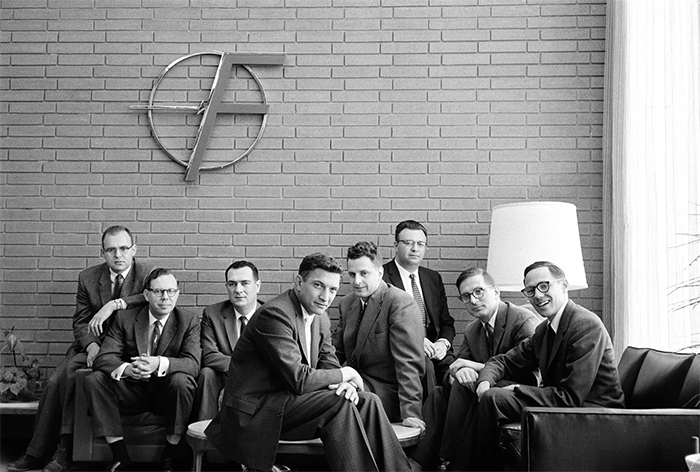
Lisa Bodell: Change Is a Choice
In this article, Lisa Bodell challenges the way we typically think about change. Rather than viewing it as a dramatic, all-or-nothing leap, she reframes change…
Thought Leader: Lisa Bodell

On April 19, 1965, an article with a title only an engineer could love — “Cramming More Components Onto Integrated Circuits” — appeared in Electronics magazine, a trade journal about the radio industry.
The earnest meditation on component-cramming by Gordon E. Moore, an electronics engineer who went on to run Intel, should have been a niche exercise. Instead, it may be the most influential trade magazine article ever published. By extrapolating from his observations in the nascent semiconductor industry near San Francisco, Moore managed to foretell the entire future of computing.
Most notably, he predicted that the number of transistors that an engineer could cram on a chip of silicon would double about every two years. This projection has been borne out so impressively over the decades that it is now known as Moore’s Law. Sixty years ago, four transistors could fit on a chip. Today some 11.8 billion can.
The extraordinary excitement of Moore’s Law, and the precarity of its ever-upward promise, are central to the pulse-quickening pace of Chris Miller’s new book, “Chip War,” which chronicles the development, proliferation and strategic deployment of the semiconductor chips that now animate everything from cars to toys to nukes. Miller, who teaches international affairs at Tufts University, brings his expertise in Russian and Chinese history to the global oligopoly that manufactures both the chips and the precise-nearly-to-the-atom tools and foundries that produce them. In the end, “Chip War” makes a whale of a case: that the chip industry now determines both the structure of the global economy and the balance of geopolitical power.
But the book is not a polemic. Rather, it’s a nonfiction thriller — equal parts “The China Syndrome” and “Mission: Impossible.” It’s also a good gift for the conservative boy reader afraid of wokeness or women. Like the hagiographic and yet fully engrossing 2012 TV docu-series “The Men Who Built America,” “Chip War” is suffused with unapologetic manliness, legitimate ingenuity, greed to beat the band and devious power plays on a world stage.
The characters, though similar in their pocket-protector mien, are wonderfully eccentric. Some are deeply unsavory. At the start, there’s William Shockley, a Nobel Prize-winning physicist and, later, an ignominious eugenicist. (Miller unaccountably leaves out Shockley’s infamous fall into racist lunacy and the late-life banking of his sperm, which he considered racially pure and dense with I.Q. points.) Shockley coinvented the transistor, which now makes up the bulk of the elements crammed by the billions onto silicon chips and which supplanted vacuum tubes in early computers.
In 1955, Shockley opened Shockley Semiconductor, in Mountain View, Calif., in part to be near his elderly mother, who lived in Palo Alto. That contingency is one reason the ancestral home of semiconductors is the San Francisco Bay Area. But the actual founding of Silicon Valley is attributed to the “traitorous eight,” a group of engineers, including Moore, who split with Shockley in 1957 because he was both so nasty and so unable to think commercially. The eight men collectively started Fairchild Semiconductor. Their leader was the Iowa-born Bob Noyce, the beloved inventor of the microchip. Noyce did not become a eugenicist. Instead, he founded Intel with Moore, and was known until he died in 1990 as the mayor of Silicon Valley.
At the start, the Soviets wanted a piece of the chip game. Miller describes the way furtive exchanges of semiconductor research between Moscow and Stanford in the 1960s created a Cold War arms race that shadowed the nuclear one. The spy games of the period also come to life. Alfred Sarant and Joel Barr, Communist New Yorkers and trained engineers, joined Julius Rosenberg’s spy ring, fled to the U.S.S.R. and helped build the Soviet computer industry. Alas, the bureaucrats under Nikita Khrushchev were so panicked about catching up to the United States that they refused to let Soviet scientists pursue their own passions, forcing them to do the undignified work of copying the integrated circuits produced by Texas Instruments, another early American semiconductor company. In this way, they fell behind, unable to keep up as chip engineers, in adherence to Moore’s Law, charged ahead at breakneck speed.
Europe’s failure to grasp the importance of transistors comes through in a great story about the French president Charles de Gaulle sniffing at a transistor radio — a gift from Hayato Ikeda, the prime minister of Japan, in 1962. De Gaulle apparently found the radio distasteful, a tacky gizmo for the petite bourgeoisie. Only much later, in the Netherlands, did Europe make its own breakthrough in chip engineering, with the invention of extreme ultraviolet (EUV) lithography, a heart-stoppingly precise technology that continued to shrink transistors when the progress of miniaturization temporarily stalled. According to Miller, one Dutch company now commands 100 percent of the EUV market, without which cutting-edge chips can’t be built.
Akio Morita, the co-founder of Sony, is another idol in Chipworld, the man who pioneered the use of chips in consumer electronics. The 15th-generation heir to a sake distillery, he refused to captain the 16th. Instead, he went all in on transistors in the 1950s, and built the company that is credited with reviving the Japanese economy after the war, chiefly by selling products like the Walkman to American markets.
Then there is China. Though some in the United States mistook Xi Jinping, the country’s president and general secretary of the Chinese Communist Party, for a reformer when he first came to power, Miller points out that, from the start, Xi “felt strong enough online to mock the Western belief that the internet would spread democratic values.” Now he has created a full-fledged authoritarian internet by building dupes of American tech companies like Google and Facebook (while banning the originals), and by allowing others into China only if they submit to its censorship policies.
What Xi Jinping’s China has failed to do is grab its expected share of the chip market. With massive government assistance, the country now produces 15 percent of the world’s silicon chips, according to Miller’s statistics, a relatively meager piece of the pie, as China clearly cannot rely on the private capital that has poured into the semiconductor sector in the rest of East Asia. The beneficiaries of this largess include Japan (which makes 17 percent of the world’s chips by Miller’s count) and Taiwan (a whopping 41 percent).
Taiwan is the Mount Olympus of silicon chips. At its summit is Morris Chang, master of economic diplomacy; founder of the Taiwan Semiconductor Manufacturing Company (TSMC) and its incomparable chip fabrication plants (“fabs”); and, at 91, the globally acknowledged Zeus of Chipworld. Having grown up peripatetic in China and British Hong Kong during the Second Sino-Japanese War, he crossed the ocean, completed an engineering degree at M.I.T. (and, later, a Ph.D. at Stanford), and, in 1958, landed at Texas Instruments, where he set his mind to improving the chip-making machinery, which had become (and remains) as much of a site of innovation as silicon chips themselves.
In what would prove a terrible error, Texas Instruments passed over Chang for C.E.O. in the early 1980s. So, at the invitation of the Taiwanese government, Chang headed to Taiwan, where he established TSMC as a set of fabs only — making chips for other companies and no finished electronics. That way, TSMC could focus on increasing efficiency in the fabs, while working with all the biggest chip designers, particularly Apple. (One excellent d’oh story Miller tells is about when Intel, which had produced chips for Apple computers for years, opted not to make chips for the iPhone. “I couldn’t see it,” Paul Otellini, Intel’s C.E.O. at the time, later explained.)
This formidable collaboration between Taiwan and the rest of the democratic world suggests that rumors of globalism’s demise are greatly exaggerated. As “Chip War” makes clear, the clash of resounding arms between autocracy and democracy is powered by silicon chips. In this clash, Taiwan is currently the unlikely epicenter of technology, global economics and China’s high-stakes rivalry with the West.
The galloping momentum of Moore’s Law is a perfect engine for Miller’s thriller. If any book can make general audiences grok the silicon age — and finally recognize how it rivals the atomic age for drama and import — “Chip War” is it. And one last note: Holy moly, it’s good to read a book about tech that’s not about software. Silicon chips are the substrate of digitization. Trying to understand the digital world by studying only Facebook or Google is like trying to understand architecture by studying only frescoes.
Lisa Bodell: Change Is a Choice
In this article, Lisa Bodell challenges the way we typically think about change. Rather than viewing it as a dramatic, all-or-nothing leap, she reframes change…
Thought Leader: Lisa Bodell
Erika Ayers Badan: 2025 In Review
I got a text the other night from my friend Erin letting me know that the year of the horse is in fact coming but…
Thought Leader: Erika Ayers Badan
Dr. Sanjay Gupta: Why You’re Breathing Wrong
Chronic disease, anxiety, ADHD, and even the shape of a person’s face could be consequences of dysfunctional breathing. And most of us, it turns out, are doing it wrong – but it’s never too late…
Thought Leader: Sanjay Gupta

